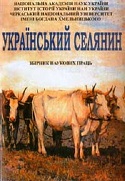СЕЛЯНСЬКИЙ ЧАСОПИС «ЛЕМКО»: ІДЕОЛОГІЯ, РУБРИКАЦІЯ, ПРОБЛЕМАТИКА
##plugins.themes.bootstrap3.article.main##
Анотація
in the focus of scientific interests of the Ruthenian subethnos research. They presented various issues of the
western branch of Ukrainians in the most comprehensive
way. At the same time, we can observe a certain tendency
in focusing only on those those publishing projects that
were created from the standpoint of Ukrainian ideology.
Thus, Lemko periodicals that were created by adherents
of other ideological orientations have been almost
completely eliminated from scientific discourse. One
vivid example of that tendency is ignoring of rather
popular Moscophiles among Lemkos. However, it is
obvious that without taking into account all points of
view, it is impossible to fully recreate the ideological
world of Lemko sub-ethnos. We believe that it is the best
to start the explanation of this tendency with the
publishing phenomenon of the «Lemko» newspaper in
Moscow.
The purpose of the article is to investigate the
ideological platform, the features of editorial policy
and the content of the Lemko newspaper.
Results. The idea of a new «Lemko» edition
emerged in early 1934 as a reaction to activation of the
publishing activity of the pro-Ukrainian part of the
Ruthenians. The «Lemko» ideological platform was
based on the theories about the Lemko autochthonous
age, the ethnic identity of the Lemkos, and their mental
unity with the world of «Ruthenian» culture. The main
stance of «Lemko» publishers was straightforwardly
anti-Ukrainianist, which contrasted sharply with progovernment rhetoric. At the heart of «Lemko’s»
historical policy, typical for most Moscophile
institutions, was the commemoration of the victims of
homicide at the Tellerhof camp in 1914. However, the
advisory and economic component of «Lemko’s»
editorial policy was quite positive. The magazine’s
editorial staff has constantly made significant efforts to
broadcast the effects of economic modernization to its
readers. Like most peasant periodicals, «Lemko» paid
close attention to the intensification of traditional
industries and the promotion of new forms of activity in
mountainous terrain.
Conclusions. The study has concluded that
«Lemko» was a unique publishing project that reflected
the little-known daily life of the Ruthenians who shared
the Moscophile values. The ideology of the newspaper
was archaic, leading to the preservation of the
Ruthenian community at the level of mental practices
of the nineteenth century. This ideological orientation
made it impossible to respond adequately to the modern
challenges of the first half of the twentieth century, which
could only be overcome by united national communities.
Therefore, despite all the significant efforts of «Lemko»
to enforce its influence on compatriots and expand its
readership, the periodical did not withstand
competition with the pro-Ukrainian edition of «Nash
Lemko» and, despite state support, after less than two
years of functioning, ceased to exist.
##plugins.themes.bootstrap3.article.details##
Посилання
Наконечний В. Часопис «Наш лемко» – феномен
русинської періодики міжвоєнного часу. Україна:
культурна спадщина, національна свідомість,
державність. 2017. Вип. 29. С. 520-528.
От редакции. Лемко. 1934. Ч. 1. С. 1.
Што каждый Лемко мусит знати о собі. Лемко. 1934.
Ч. 1. С. 1.
Ци єст даяка рада на кризи. Лемко. 1934. Ч. 7. С. 1.
Политика в нашых церквах. Лемко. 1934. Ч. 1. С. 2.
Як отбылася в Сяноці украинска парада в честь
епископа Коцыловского. Лемко. 1934. Ч. 1. С. 2-3.
Именины Маршала Пилсудского. Лемко. 1934. Ч. 2.
С. 1.
Тельвак В. Творча спадщина Михайла Грушевського
в оцінках сучасників (кінець ХІХ – 30-ті роки ХХ століття).
Київ ; Дрогобич : Вимір, 2008. 494 с.
Отдаймме всенародный поклон. Лемко. 1934. Ч. 6. С.
Што нам робити. Лемко. 1934. Ч. 5. С. 1.
Сто тисяч делегатов хлопскых на собраню в столиці.
Лемко. 1934. Ч. 3. С. 1.
Що нам грозит?! Лемко. 1934. Ч. 4. С. 1.

